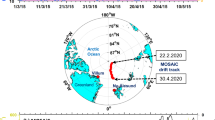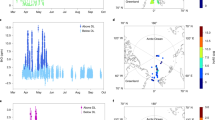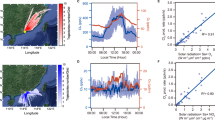Abstract
Following the springtime polar sunrise, ozone concentrations in the lower troposphere episodically decline to near-zero levels1. These ozone depletion events are initiated by an increase in reactive bromine levels in the atmosphere2,3,4,5. Under these conditions, the oxidative capacity of the Arctic troposphere is altered, leading to the removal of numerous transported trace gas pollutants, including mercury6. However, the sources and mechanisms leading to increased atmospheric reactive bromine levels have remained uncertain, limiting simulations of Arctic atmospheric chemistry with the rapidly transforming sea-ice landscape7,8. Here, we examine the potential for molecular bromine production in various samples of saline snow and sea ice, in the presence and absence of sunlight and ozone, in an outdoor snow chamber in Alaska. Molecular bromine was detected only on exposure of surface snow (collected above tundra and first-year sea ice) to sunlight. This suggests that the oxidation of bromide is facilitated by a photochemical mechanism, which was most efficient for more acidic samples characterized by enhanced bromide to chloride ratios. Molecular bromine concentrations increased significantly when the snow was exposed to ozone, consistent with an interstitial air amplification mechanism. Aircraft-based observations confirm that bromine oxide levels were enhanced near the snow surface. We suggest that the photochemical production of molecular bromine in surface snow serves as a major source of reactive bromine, which leads to the episodic depletion of tropospheric ozone in the Arctic springtime.
This is a preview of subscription content, access via your institution
Access options
Subscribe to this journal
Receive 12 print issues and online access
$259.00 per year
only $21.58 per issue
Buy this article
- Purchase on Springer Link
- Instant access to full article PDF
Prices may be subject to local taxes which are calculated during checkout



Similar content being viewed by others
References
Barrie, L. A., Bottenheim, J. W., Schnell, R. C., Crutzen, P. J. & Rasmussen, R. A. Ozone destruction and photochemical-reactions at polar sunrise in the lower Arctic atmosphere. Nature 334, 138–141 (1988).
McConnell, J. C. et al. Photochemical bromine production implicated in Arctic boundary-layer ozone depletion. Nature 355, 150–152 (1992).
Fan, S-M. & Jacob, D. J. Surface ozone depletion in Arctic spring sustained by bromine reactions on aerosols. Nature 359, 522–524 (1992).
Finlayson-Pitts, B. J., Livingston, F. E. & Berko, H. N. Ozone destruction and bromine photochemistry at ground level in the Arctic spring. Nature 343, 622–625 (1990).
Vogt, R., Crutzen, P. J. & Sander, R. A mechanism for halogen release from sea-salt aerosol in the remote marine boundary layer. Nature 383, 327–330 (1996).
Schroeder, W. H. et al. Arctic springtime depletion of mercury. Nature 394, 331–332 (1998).
Abbatt, J. P. D. et al. Halogen activation via interactions with environmental ice and snow in the polar lower troposphere and other regions. Atmos. Chem. Phys. 12, 6237–6271 (2012).
Maslanik, J., Stroeve, J., Fowler, C. & Emery, W. Distribution and trends in Arctic sea ice age through spring 2011. Geophys. Res. Lett. 38, L13502 (2011).
Liao, J. et al. Observations of inorganic bromine (HOBr, BrO, and Br2) speciation at Barrow, AK, in spring 2009. J. Geophys. Res. 117, D00R16 (2012).
Abbatt, J. et al. Release of gas-phase halogens by photolytic generation of OH in frozen halide-nitrate solutions: An active halogen formation mechanism? J. Phys. Chem. A 114, 6527–6533 (2010).
France, J. L. et al. Hydroxyl radical and NOx production rates, black carbon concentrations and light-absorbing impurities in snow from field measurements of light penetration and nadir reflectivity of onshore and offshore coastal Alaskan snow. J. Geophys. Res. 117, D00R12 (2012).
George, I. J. & Anastasio, C. Release of gaseous bromine from the photolysis of nitrate and hydrogen peroxide in simulated sea-salt solutions. Atmos. Environ. 41, 543–553 (2007).
Křepelová, A., Huthwelker, T., Bluhm, H. & Ammann, M. Surface chemical properties of eutectic and frozen NaCl solutions probed by XPS and NEXAFS. ChemPhysChem 11, 3859–3866 (2010).
Domine, F., Sparapani, R., Ianniello, A. & Beine, H. J. The origin of sea salt in snow on Arctic sea ice and in coastal regions. Atmos. Chem. Phys. 4, 2259–2271 (2004).
Douglas, T. A. et al. Frost flowers growing in the Arctic ocean–atmosphere–sea ice-snow interface: 1. Chemical composition. J. Geophys. Res. 117, D00R09 (2012).
Huff, A. K. & Abbatt, J. P. D. Kinetics and product yields in the heterogeneous reactions of HOBr with ice surfaces containing NaBr and NaCl. J. Phys. Chem. A 106, 5279–5287 (2002).
Sjostedt, S. J. & Abbatt, J. P. D. Release of gas-phase halogens from sodium halide substrates: Heterogeneous oxidation of frozen solutions and desiccated salts by hydroxyl radicals. Environ. Res. Lett. 3, 045007 (2008).
Adams, J. W., Holmes, N. S. & Crowley, J. N. Uptake and reaction of HOBr on frozen and dry NaCl/NaBr surfaces between 253 and 233 K. Atmos. Chem. Phys. 2, 79–91 (2002).
Dominé, F. & Shepson, P. B. Air–snow interactions and atmospheric chemistry. Science 297, 1506–1510 (2002).
Sumner, A. L. & Shepson, P. B. Snowpack production of formaldehyde and its effect on the Arctic troposphere. Nature 398, 230–233 (1999).
Aguzzi, A. & Rossi, M. J. Heterogeneous hydrolysis and reaction of BrONO2 and Br2O on pure ice and ice doped with HBr. J. Phys. Chem. A 106, 5891–5901 (2002).
Nissenson, P., Packwood, D. M., Hunt, S. W., Finlayson-Pitts, B. J. & Dabdub, D. Probing the sensitivity of gaseous Br2 production from the oxidation of aqueous bromide-containing aerosols and atmospheric implications. Atmos. Environ. 43, 3951–3962 (2009).
Foster, K. L. et al. The role of Br2 and BrCl in surface ozone destruction at polar sunrise. Science 291, 471–474 (2001).
Oum, K. W., Lakin, M. J. & Finlayson-Pitts, B. J. Bromine activation in the troposphere by the dark reaction of O3 with seawater ice. Geophys. Res. Lett. 25, 3923–3926 (1998).
Platt, U. & Stutz, J. Differential Optical Absorption Spectroscopy: Principles and Applications, Physics of Earth and Space Environments (Springer, 2008).
Langendorfer, U., Lehrer, E., Wagenbach, D. & Platt, U. Observation of filterable bromine variabilities during Arctic tropospheric ozone depletion events in high (1 hour) time resolution. J. Atmos. Chem. 34, 39–54 (1999).
Simpson, W. R. et al. First-year sea-ice contact predicts bromine monoxide (BrO) levels at Barrow, Alaska better than potential frost flower contact. Atmos. Chem. Phys. 7, 621–627 (2007).
Kwok, R. et al. Airborne surveys of snow depth over Arctic sea ice. J. Geophys. Res. 116, http://dx.doi.org/10.1029/2011JC007371 (2011).
Krnavek, L. et al. The chemical composition of surface snow in the Arctic: Examining marine, terrestrial, and atmospheric influences. Atmos. Environ. 50, 349–359 (2012).
Wren, S. N. & Donaldson, D. J. How does deposition of gas phase species affect pH at frozen salty interfaces? Atmos. Chem. Phys. 12, 10065–10073 (2012).
Acknowledgements
Financial support was provided by the National Science Foundation Office of Polar Programs (ARC-1107695) and the National Aeronautics and Space Administration (NASA) Cryospheric Sciences Program as a part of the NASA Interdisciplinary Research on Arctic Sea Ice and Tropospheric Chemical Change (09-IDS09-31). K.A.P. is supported by a National Science Foundation Postdoctoral Fellowship in Polar Regions Research. S. V. Nghiem is thanked for BROMEX organization. The MODIS image in Fig. 3 was provided by the NASA Rapid Response MODIS Subset in support of BROMEX. R. Replogle (Purdue University) is thanked for construction of the snow chamber. Solar radiation data were acquired by and obtained from the NOAA/ESRL/GMD Solar Radiation group. We are grateful to UMIAQ and CH2M Hill Polar Services for field logistical assistance. M. O. L. Cambaliza and D. Caulton (Purdue University) are thanked for aircraft attitude data used in the DOAS analysis. E. Boone (Purdue University) is thanked for aerosol data analysis. M. Sturm (CRREL) is thanked for chamber design advice. J. W. Halfacre (Purdue University) is thanked for calibration of the ozone monitor. R. Lieb-Lappen (Dartmouth University) is thanked for field discussions. This is publication 1241 of the Purdue Climate Change Research Center.
Author information
Authors and Affiliations
Contributions
P.B.S. and K.A.P. designed the experiments, which were conducted by K.A.P. and K.D.C. K.A.P. wrote the manuscript. P.B.S., K.A.P, K.D.C. and M.C. designed the snow chamber. T.A.D. collected samples from the sea ice, provided guidance for tundra snow sampling and contributed to discussions. P.B.S., D.P., S.G. and J.Z. conducted the aircraft-based BrO measurements with aircraft assistance from B.H.S. W.R.S. and U.P. contributed to discussions and were other principal investigators of the BrO study. D.J.T. and L.G.H. provided assistance with chemical ionization mass spectrometry. All authors reviewed and commented on the paper.
Corresponding author
Ethics declarations
Competing interests
The authors declare no competing financial interests.
Supplementary information
Supplementary Information
Supplementary Information (PDF 1407 kb)
Rights and permissions
About this article
Cite this article
Pratt, K., Custard, K., Shepson, P. et al. Photochemical production of molecular bromine in Arctic surface snowpacks. Nature Geosci 6, 351–356 (2013). https://doi.org/10.1038/ngeo1779
Received:
Accepted:
Published:
Issue Date:
DOI: https://doi.org/10.1038/ngeo1779
This article is cited by
-
Year-round trace gas measurements in the central Arctic during the MOSAiC expedition
Scientific Data (2022)
-
Arctic mercury cycling
Nature Reviews Earth & Environment (2022)
-
Major atmospheric particulate matter sources for glaciers in Coquimbo Region, Chile
Environmental Science and Pollution Research (2021)
-
Organic bromine compounds produced in sea ice in Antarctic winter
Nature Communications (2018)
-
Canadian Arctic sea ice reconstructed from bromine in the Greenland NEEM ice core
Scientific Reports (2016)



